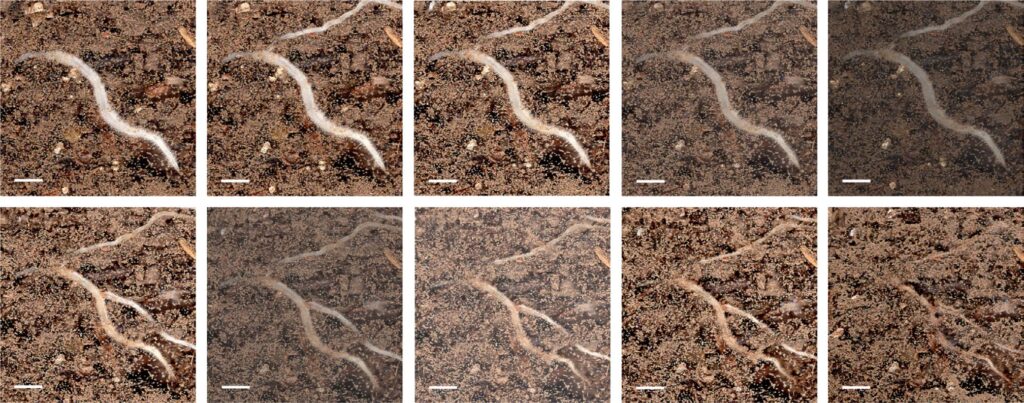
Noticias e atualizações – Front Agrociência
Morfologia de raízes finas e pêlos radiculares de algodoeiro sob seca estresse revelado com RhizoPot
Fine root and root hair morphology of cotton under drought stress revealed with RhizoPot


Nome do Autor
Resumo sobre o autor
Shuang Xiao ¹ | Liantao Liu ¹ | Yongjiang Zhang ¹ | Hongchun Sun ¹ | Ke Zhang ¹ | Zhiying Bai ¹ | ¹ Hezhong Dong² | Cundon Li ¹
¹ State Key Laboratory of North China Crop Improvement and Regulation/Key Laboratory of Crop Growth Regulation of Hebei Province, Hebei Agricultural University, Baoding, China
² Cotton Research Center/Key Laboratory of Cotton Breeding and Cultivation in Huanghuai-hai Plain, Ministry of Agriculture, Shandong Academy of Agricultural Sciences, Jinan, China
Correspondence Cundong Li, College of Agronomy, Hebei Agricultural University, Baoding 071000, China.
Email: nxylcd@hebau.cn funding information
National Natural Science Foundation of China (No. 31871569); Modern Technology System of Agricultural Industry in Hebei (HBCT2018040201, CL); Fund of Research Group Construction for Crop Science in Hebei Agricultural University (TD2016C318)
Abstract
Fine roots (roots with a diameter of less than 2 mm) and root hairs are the primary absorbers of water and nutrients; however, the morphology of cotton fine roots and root hairs in response to drought stress has not yet been defined. To solve this problem, this study characterized a self-made in situ root observation device (RhizoPot) with a scanner with a resolution of up to 4,800 DPI was used to observe the roots of cotton plants grown indoors under both well-watered and drought stress conditions. RhizoPot provided healthy growth conditions for cotton, and fine roots as well as root hairs were successfully observed. Root length density increased significantly under drought stress, whereas the average root diameter decreased gradually with the extension of treatment time. Drought stress accelerated fine root death, and the diameter of the fine roots was positively correlated with root lifespan. Additionally, the root hair lifespan was negatively regulated by soil drought stress and was associated with the growth stage. This result suggests that cotton developed more slender fine roots and longer root hairs under drought stress, which accelerated the death process of both, in order to develop new fine roots. This process helps cotton absorb as much water as possible under drought stress.
KEYWORDS
high-resolution imaging, imaging scan, lifespan, plant–soil interaction, Rhizosphere, soil drought
Raízes finas (raízes com diâmetro menor que 2 mm) e pelos radiculares são os principais absorvedores de água e nutrientes; no entanto, a morfologia das raízes finas e pelos radiculares do algodão em resposta ao estresse hídrico ainda não foi definida. Para resolver esse problema, este estudo caracterizou um dispositivo de observação de raízes in situ feito por ele mesmo (RhizoPot) com um scanner com resolução de até 4.800 DPI foi usado para observar as raízes de plantas de algodão cultivadas em ambientes internos sob condições de estresse hídrico e bem regadas. O RhizoPot forneceu condições saudáveis de crescimento para o algodão, e raízes finas e pelos radiculares foram observados com sucesso. A densidade do comprimento da raiz aumentou significativamente sob estresse hídrico, enquanto o diâmetro médio da raiz diminuiu gradualmente com a extensão do tempo de tratamento. O estresse hídrico acelerou a morte da raiz fina, e o diâmetro das raízes finas foi positivamente correlacionado com a vida útil da raiz. Além disso, a vida útil do pelo radicular foi regulada negativamente pelo estresse hídrico do solo e foi associada ao estágio de crescimento. Este resultado sugere que o algodão desenvolveu raízes finas mais finas e pelos radiculares mais longos sob estresse de seca, o que acelerou o processo de morte de ambos, a fim de desenvolver novas raízes finas. Este processo ajuda o algodão a absorver o máximo de água possível sob estresse de seca.
PALAVRAS-CHAVE
imagem de alta resolução, varredura de imagem, tempo de vida, interação planta-solo, Rizosfera, solo seca
Acesse o artigo completo e sua descrição
Nome do arquivo
Descrição completa e PDF para Download
Morfologia de raiz de algodão.pdf
Referências
Cruz de Carvalho, M. H. (2008). Drought stress and reactive oxygen species: Production, scavenging and signaling. Plant Signaling & Behavior, 3(3), 156–165. https://doi.org/10.4161/psb.3.3.5536
Farooq, M., Wahid, A., Kobayashi, N., Fujita, D., & Basra, S. M. A. (2009). Plant drought stress: effects, mechanisms and management. In E. Lichtfouse, M. Navarrete, P. Debaeke, S. Véronique, & C. Alberola (Eds.), Sustainable Agriculture (pp. 153–188). Dordrecht: Springer. https://doi.org/10.1007/978-90-481-2666-8_12
Lobet, G., & Draye, X. (2013). A novel method for the observation of root growth in the soil. Scientia Horticulturae, 162, 100–105. https://doi.org/10.1016/j.scienta.2013.07.034
Arteca, R. N., & Arteca, J. M. (2002). A novel method for growing Arabidopsis thaliana plants hydroponically. Physiologia Plantarum, 108(2), 188–193. https://doi.org/10.1034/j.1399-3054.2000.108002188.x
Bates, T. R., & Lynch, J. P. (1996). Stimulation of root hair elongation in Arabidopsis thaliana by low phosphorus availability. Plant, Cell & Environment, 19(5), 529–538. https://doi.org/10.1111/j.1365-3040.1996.tb00386.x
Bengough, A. G., Gordon, D. C., Al-Menaie, H., Ellis, R. P., Allan, D., Keith, R., … Forster, B. P. (2004). Gel observation chamber for rapid screening of root traits in cereal seedlings. Plant and Soil, 262(1–2), 63–70. https://doi.org/10.1023/B:PLSO.0000037029.82618.27
Berry, J. A., & Downton, W. J. S. (1982). Environmental regulation of photosynthesis. In: Govindjee (Ed.), Photosynthesis (pp. 263–343). New York: Academic Press.
Bohm, W. (1974). Mini-rhizotrons for root observations under field conditions. Zeitschrift Fur Acker Und Pfanzenbau, 140, 282–287.
Brunner, I., Herzog, C., Galiano, L., & Gessler, A. (2019). Plasticity of fine-root traits under long-term irrigation of a water-limited scots pine forest. Frontiers in Plant Science, 10, 701. https://doi.org/10.3389/fpls.2019.00701
Burke, M. K., & Raynal, D. J. (1994). Fine root growth phenology, production, and turnover in a northern hardwood forest ecosystem. Plant and Soil, 162(1), 135–146. https://doi.org/10.1007/BF01416099
Cao, X., Chen, C. L., Zhang, D. J., Bo, S., Jie, X., & Xia, R. X. (2013). Influence of nutrient deficiency on root architecture and root hair morphology of trifoliate orange (Poncirus trifoliata L. Raf.) seedlings under sand culture. Scientia Horticulturae, 162, 100–105. https://doi.org/10.1016/j.scienta.2013.07.034
Chen, J., Liu, L., Wang, Z., Sun, H., Zhang, Y., Bai, Z., … Li, C. (2019). Nitrogen fertilization effects on physiology of the cotton boll–leaf system. Agronomy, 9(6), 271. https://doi.org/10.3390/agronomy9060271
Cheng, X. R., Huang, M. B., Shao, M. A., & Warrington, D. N. (2009). A comparison of fine root distribution and water consumption of mature Caragana korshinkii Kom grown in two soils in a semiarid region, China. Plant and Soil, 315(1–2), 149–161. https://doi.org/10.1007/s11104-008-9739-5
Clark, R. T., Maccurdy, R. B., Jung, J. K., Shaff, J. E., Mccouch, S. R., Aneshansley, D. J., & Kochian, L. V. (2011). Three-dimensional root phenotyping with a novel imaging and software platform. Plant Physiology, 156(2), 455–465. https://doi.org/10.1104/pp.110.169102
Colquhoun, A. J., & Hillman, J. R. (1975). Endogenous abscisic acid and the senescence of leaves of Phaseolus vulgaris L. Zeitschrift Für Pflanzenphysiologie, 76(4), 326–332. https://doi.org/10.1016/S0044-328X(75)80059-6
Eissenstat, D. M., & Yanai, R. D. (1997). The ecology of root lifespan. Advances in Ecological Research, 27, 1–60. https://doi.org/10.1016/S0065-2504(08)60005-7
Farooq, M., Wahid, A., Kobayashi, N., Fujita, D., & Basra, S. M. A. (2009). Plant drought stress: effects, mechanisms and management. Sustainable Agriculture, 153–188. https://doi.org/10.1007/978-90-481-2666-8_12
Gahoonia, T. S., & Nielsen, N. E. (1991). A method to study rhizosphere processes in thin soil layers of different proximity to roots. Plant and Soil, 135(1), 143–146. https://doi.org/10.1007/BF00014787
Para ler todas as referencias, acesse o artigo completo aqui.
Encontrou alguma informação incorreta ou com falta de dados? Entre em contato agora mesmo!
Todos os direitos reservados a Front Agrociência LTDA. Desenvolvido por Agência Errigê